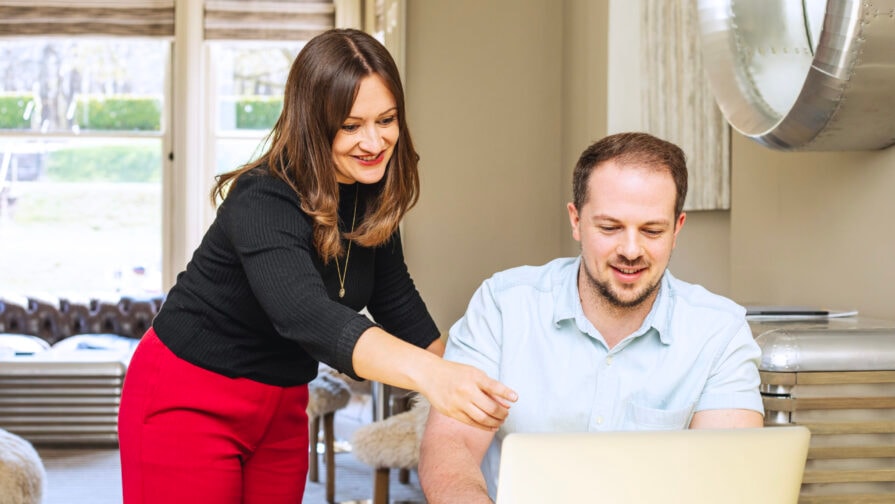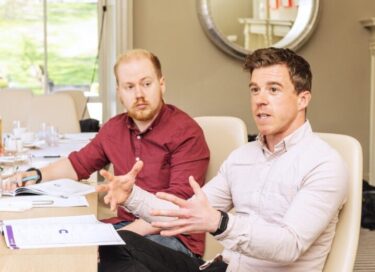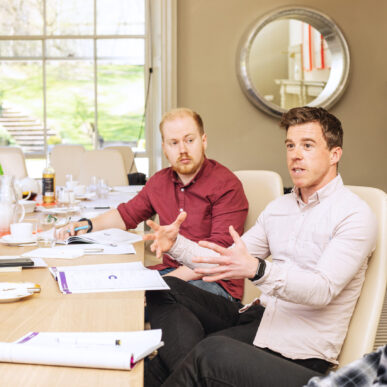Assertive communication is the difference between being heard and being overlooked. When you know how to speak up with clarity, confidence, and respect, you create space for action, trust, and change.
At Body Talk, we’ve empowered over 120,000 people to develop those exact skills. From resolving tension in teams to leading under pressure, assertive communication is the thread that runs through everything we teach
In this guide, we’ll break down what assertive communication really means, why it matters, and how you can master it. Whether you’re managing a team, speaking to clients, or navigating tough conversations, this is where confident communication starts.
What is assertive communication?
Let’s go into more detail on exactly what assertive communication is.
Assertive communication definition
Assertive communication is the ability to express your thoughts, feelings and needs clearly, while still respecting the views of others. It’s not about being the loudest voice in the room. It’s about owning your message with confidence, clarity and calm authority.
Many people confuse assertiveness for aggression, but they’re not the same. In fact, assertiveness is one of the most respectful and emotionally intelligent ways to communicate. When done well, it builds trust, strengthens relationships and empowers everyone in the conversation – not just the person speaking.
Characteristics of assertive communication
Assertive communicators know how to speak up without shutting others down, and how to hold their space while staying open to others.
Here’s what that looks like in action:
- Respectful, clear language – You say what you mean without being blunt or dismissive.
- “I” statements and a confident tone – Instead of pointing fingers, you take ownership of your message.
- Open body language and active listening – You maintain eye contact, you listen well, and you stay present, recognising that body language is just as impactful as verbal communication.

Assertive vs. aggressive communication
Aggressive communicators push too hard. Their tone is forceful, their words dominate, and the impact often leaves others feeling shut down. It might sound like:
- “You obviously don’t get it.”
- “If you can’t handle this, maybe you’re in the wrong role.”
This approach might feel powerful in the moment, but it erodes trust and teamwork. Assertiveness, on the other hand, speaks with respect.
Assertive vs. passive communication
Passive communicators tend to withhold their needs or opinions, often out of fear of conflict or rejection. Many people struggle with this in the workplace. It can sound like:
- “I’m fine with whatever works for everyone else.”
- “Sure, I’ll do it. I don’t mind.” (You do mind!)
While it might seem easier in the moment, staying passive risks creating tension below the surface. You start to feel overlooked, stressed, or resentful – and those feelings build up.
Assertiveness is the antidote. It gives you the tools to express yourself with clarity and care. You speak up sooner, set boundaries with confidence, and avoid the pressure-cooker effect of things left unsaid.
Assertive vs. passive aggressive communication
Passive-aggressive communication surfaces when someone feels overlooked, overworked, or unheard, but doesn’t feel confident enough to say so directly. It might sound like:
- “I guess I’ll do it, since no one else has time.”
This style creates confusion and resentment. Assertiveness clears the air, replacing assumptions with open dialogue, so misunderstandings are dealt with – not danced around.
Examples of assertive communication in action
What does assertive communication look like in everyday situations?
Asking for what you need at work
Instead of: “Sorry to bother you, it’s probably not urgent…”
Try: “I could use your input on this proposal to move it forward. Could we set aside 15 minutes today?”
It’s a clear, confident ask that shows respect for their time without undermining your own priorities. No apology necessary.
Replacing filler words
Instead of: “I just wanted to check if this sounds okay?”
Try: “Here’s what I’ve written. I’d welcome your thoughts.”
Being direct doesn’t mean being abrupt, it means trusting your voice and giving others something clear to respond to.
Giving feedback
Instead of: “You always make this same mistake.”
Try: “I really appreciate your work on this. One thing I noticed was (specific issue). Here’s how I think we can improve it moving forward.”
Assertive feedback is direct and forward-focused. It shows belief in the other person’s ability to grow, and in your own ability to lead with clarity.
Having a difficult conversation with a supplier
Instead of: “This isn’t good enough.”
Try: “We’ve noticed recurring delays in delivery over the past month, which is impacting our timelines. Can we talk through what’s causing it and how we can prevent it going forward?”
This wording is specific about the issue and opens the door to collaboration, without backing down on expectations. Our communication specialists at Body Talk cover this in our conflict resolution training courses, equipping you with practical techniques to handle questions, challenges and objections with confidence.

What are the benefits of assertive communication?
Assertive communication brings many benefits to the table. When you learn to communicate assertively, everything changes, from how you manage pressure to how others respond to you.
Assertive communication has the potential to:
Reduce stress and conflict
Dr Laura Aylward, writing for the Society of Behavioral Medicine, explains that stress – from a cognitive perspective – arises when the demands placed on us exceed the resources we believe we have to manage them. Assertive communication, she notes, lowers stress by helping you feel more in control.
It’s not about raising your voice, it’s about raising your standards. You decide how to respond, rather than react. You set healthy boundaries that protect your time, your energy, and your peace of mind.
Boost self-confidence
When your voice lands with clarity and intention, you feel it. You stand taller, you think sharper, you connect more powerfully. Assertiveness isn’t just about speaking up, it’s about knowing your voice matters.
In fact, according to a study by the World Health Organization, 60% of social care workers felt more empowered to support their clients after using assertive communication techniques. When you communicate with purpose and presence, you naturally elevate the impact you make.
Improve leadership and team collaboration
Assertiveness helps leaders rise. It invites honest dialogue, encourages accountability, and creates space where teams feel seen and supported.
In a study of leaders published by Forbes, researchers explored how assertiveness and good judgment shape the effectiveness of leadership. They found:
- Leaders who were seen as good decision-makers but not assertive had only a 4% chance of being rated as highly effective leaders.
- Those who were assertive but lacked sound judgment had a 12.5% chance.
- But leaders who demonstrated both assertiveness and good judgment had a 71% chance of being viewed as top-tier.
The takeaway? Assertiveness, combined with insight, is a defining trait of exceptional leadership. It helps leaders communicate clearly, set direction with confidence, and earn the trust that moves teams forward.
Build stronger relationships
All of the things that assertive communication brings to the table – better stress management, greater self-confidence, improved leadership – naturally feeds into stronger professional relationships. You become someone others want to work with, listen to, and follow.
When you speak clearly and respectfully, people trust you. They know where you stand. That kind of honesty builds mutual respect – the foundation of positive relationships.

How to develop an assertive communication style
Assertiveness isn’t a fixed trait, it’s a skill that anyone can build. These techniques give you the structure and tools to develop a communication style that’s clear, respectful, and grounded in self-belief.
Use “I” statements
There’s power in owning your perspective. “I” statements allow you to share how you feel without placing blame. They keep conversations respectful and real, even when you’re tackling tough topics or handling objections.
Avoid judgement or assumptions
When we assume the other person’s motives, we stop listening. We fill in the blanks with our own story, and that story often leads to frustration. Meanwhile, the other person feels misjudged and unheard.
Focus on what you’ve observed – not what you think it means. Stay grounded in facts and open to their point of view.
You’re not here to accuse. You’re here to understand and create space for them to explain.
For instance, instead of: “You’re clearly not interested in this project.”
You might say: “I noticed you haven’t contributed as much in the last few meetings.”
Learn to say “no” with confidence
You have the right to protect your time, your energy, and your values. Saying “no” isn’t negative, it’s a form of self-respect. When you set boundaries clearly and kindly, you show others how to work with you instead of walk over you.
Tips for practising assertiveness daily
Building assertiveness is like building a muscle. The more you use it, the stronger it gets. Try using positive affirmations to improve your mindset, role playing to think about how you could apply assertive communication in different scenarios, and setting communication goals.
Want to take it further? Our blog on the seven ways to be an assertive communicator is your next step, packed with strategies to speak with impact and own every conversation.
Transformative assertive communication skills training from Body Talk
Body Talk coaches are communication specialists, drawing on decades of experience in broadcasting, journalism, national television and theatre to bring you tools that truly work. Our communication skills training is designed for real-world challenges, whether you’re looking to grow as a leader, empower your team, or simply speak up and be heard.
No matter your challenge, there’s a Body Talk course that can help you rise to it.
Explore our communication skills training courses and start transforming the way you connect, lead and influence today.
Frequently asked questions
We’ve answered some of the most common questions on assertive communication below. Got a question we haven’t covered? We’d love to hear from you.
What is a lack of assertiveness skills?
Lacking assertiveness skills often means struggling to express your needs in a clear, confident, and respectful way. When you’re not communicating in an assertive manner, it’s easy to swing between staying silent or reacting with an aggressive response, neither of which leads to healthy communication.
Over time, this imbalance can leave you feeling frustrated, overlooked, or even angry. You may constantly compromise your own needs to avoid conflict, which can chip away at your self-esteem and affect your ability to manage stress effectively.
Developing assertiveness is about finding that balance. Speaking up with clarity and calm, while respecting others. It’s one of the most empowering skills you can build.
What are the golden rules of assertiveness?
Mastering assertiveness starts with a few guiding principles. Whether you’re leading teams or working with patients as a healthcare professional, these rules help you communicate with confidence and authenticity:
- Stay aware of your mindset and energy.
- Let your assertive body language do the talking, with an open posture, steady voice, and calm presence.
- Speak with honesty and empathy. Say what you mean, without apology or aggression.
- Create space for others to share their point of view. Assertiveness listens, too.
- Strengthen your skills with assertiveness training and the right social support.


















